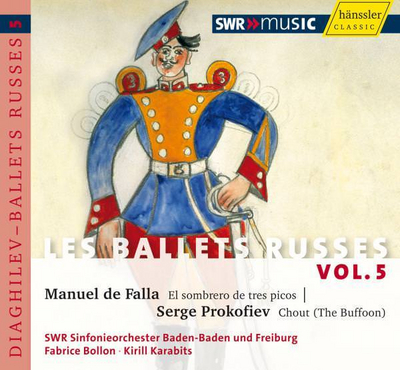Diaghilev, Sergei: Les Ballets Russes Vol. 5

2008
2009
Manuel de Falla
Sergej Prokofjew
Ofelia Sala
SWR Sinfonieorchester Baden-Baden und Freiburg
Fabrice Bollon
Kirill Karabits
Manuel de Falla: The Three Cornered Hat
Sergej Prokofjew: Chout op. 21 (Der Narr, 1921)
When de Falla wrote The Three-Cornered Hat after a story by Pedro Antonio de Alarcón during 1916-19, he was already a famous composer. The first version of the piece was written as a pantomime, and Diaghilev saw this version in Madrid and was enthusiastic. He commissioned de Falla to write a ballet, and when World War I came to an end, de Falla had also finished The Three-Cornered Hat. The ballet premiere was held in London in 1919, the conductor was Ernest Ansermet, and the stage designer was Picasso – it was his first painting project for the stage. He completed the stage curtain during the final rehearsals; Diaghilev asked de Falla for the addition of an introduction that would give the public more time to admire the curtain, and de Falla delivered within twenty-four hours. The Three-Cornered Hat is a wonderful work, among de Falla’s finest, and here it is recorded in full with song.
Prokofiev’s Chout has as its basis the Russian tale of the “Fool Who Outfooled Seven Fools.” “But write a music that truly deserves to be called Russian,” Diaghilev commanded. “Among your people, in your lazy St. Petersburg, one has long forgotten how to compose in the Russian mode.” Although Prokofiev had the score finished in 1917, Chout was first premiered four years later with the title Le Bouffon. The stage set, costumes, and choreography were in the hands of the Russian painter Larionov, a futurist and the inventor of the painting style known as “rayonnism.” The success was limited, and Diaghilev summed up, “The best part is the music, the next best is the décor, and the worst is the choreography.” During the following year Prokofiev gathered together large parts of his ballet music, which offers grotesquery, motoric drive, massive sound blocks but also considerable late-impressionistic refinement, to form a concert suite containing the most important scenes of this surreal and violent tale – and it is this work that is heard here.